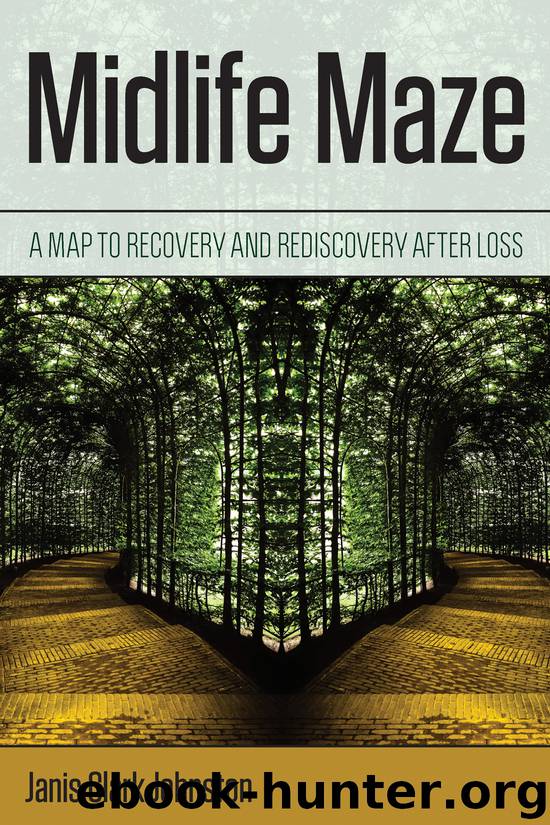Midlife Maze by Janis Clark Johnston

Author:Janis Clark Johnston
Language: eng
Format: epub
Publisher: Rowman & Littlefield Publishers
Chapter 9
Inviting Belonging Connections
The world needs all its flowers, just as they are, and even though they bloom for only the briefest of moments. … It is our job to find out … what kind of flowers we are, and to share our unique beauty with the world in the precious time that we have, and to leave … a legacy of wisdom and compassion embodied in the way we live.
– Jon Kabat-Zinn, meditation teacher, Coming to Our Senses
Only in growth, reform and change, paradoxically enough, is true security to be found.
– Anne Morrow Lindbergh, aviator and writer
Meeting your need for belonging or attachment relates to having intimate, ongoing contact with family and friends. You may ask, is belonging really a basic need? Yes, your brain develops within a social context: “One cannot develop a sense of self without a sense of the other. Humans evolved to be especially sensitive to social cues. In fact, the complexity of dealing with group social life is believed to be one of the key reasons our brains became so big.”1 The irony of our big brains and keen sense of belongingness is that some of our most cherished values – self-sacrifice, kindness, and cooperation – have been employed to help groups of people succeed in war: “Indeed, research has shown that group bonds are strengthened by conflict with outsiders. A common enemy can certainly unite people.”2 We need to increase our group belongingness ties without having to focus on “out” groups. Not only is it possible to have belongingness based upon common causes that affirm other people, it is more joyful and healing.
There is research to back up the notion that your attachments to others constitute a very important need. Psychologists Roy Baumeister and Mark Leary studied belongingness and the impact of a person’s lack of belonging ties. Their research findings deviate both from Sigmund Freud’s theory proposing sex and aggression as driving human behavior, and psychologist John Watson’s behaviorism model of human behavior: “Give me a dozen healthy infants, well-formed, and my own specified world to bring them up in and I’ll guarantee to take any one at random and train him to become any type of specialist I might select - doctor, lawyer, artist, merchant-chief and, yes, even beggar-man and thief, regardless of his talents, penchants, tendencies, abilities, vocations and the race of his ancestors.”3 Instead, Baumeister and Leary found that humans thrive and grow best when they both establish and sustain belongingness with other people.4 Furthermore, after experiencing loss of a beloved person, an important aspect of grieving is to savor precious relationship memories.
Some loss situations are so tragic that the well-being of the following generation is affected. Rachel Yehuda, neuroscience professor and director of the Traumatic Stress Studies Division at Mount Sinai School of Medicine in New York, studied both children of Holocaust survivors and pregnant women who survived the 9/11 attacks in New York City. Yehuda found that the pregnant women who had developed posttraumatic stress disorder (PTSD)
Download
This site does not store any files on its server. We only index and link to content provided by other sites. Please contact the content providers to delete copyright contents if any and email us, we'll remove relevant links or contents immediately.
They Both Die at the End by Adam Silvera(8616)
Thirteen Reasons Why by Jay Asher(7795)
The Space Between by Michelle L. Teichman(6091)
Suicide Notes by Michael Thomas Ford(4274)
Tuesdays with Morrie by Mitch Albom(3835)
Suicide: A Study in Sociology by Emile Durkheim(2611)
The Checklist Manifesto by Atul Gawande(2205)
Tuesdays With Morrie by Mitch Albom(2173)
Robin by Dave Itzkoff(2007)
In the Woods by Tana French(2003)
Bossypants by Tina Fey(1988)
No Ashes in the Fire by Darnell L Moore(1983)
Reservoir 13 by Jon McGregor(1855)
End of Days by Sylvia Browne(1827)
Olive Kitteridge by Elizabeth Strout(1794)
Bus on Jaffa Road by Mike Kelly(1785)
All Things New by John Eldredge(1783)
Scar Tissue by Anthony Kiedis(1771)
No Time to Say Goodbye(1761)
